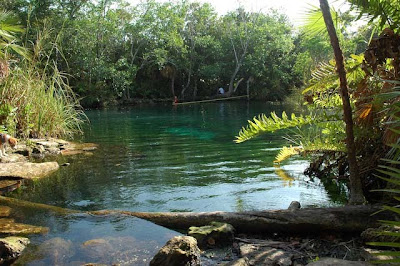Most of the general "facts" presented below are from the Wikipedia article on cenotes. Photos and details about the specific cenotes are all from TodoTulum.
Escondido Cenote
"Cenote" is the Mayan word meaning "well," and they're basically sinkholes that have filled with groundwater. They're fairly unique to the Riviera Maya region, and a few other Caribbean islands.
Because of the proximity to the ocean, some of the cenotes have what is called a halocline - an area where the freshwater and saltwater mixes, which creates a blurry, swirling effect that is supposedly pretty cool. The saltwater is heavier and so the fresh water floats on top of the saltwater.
Gran Cenote
Some of the cenotes look more like beautiful, large pools. Most have networks of underground caves or caverns, but some - like the Gran pictured above - are actually high enough that swimmers can navigate within the caves and caverns.
Dos Ojos is another very popular cenote. It's relatively shallow which means that the snorkelers can watch the scuba divers below and see some of the hidden caves from their lights. It's also apparently beautiful when the sun light streams in.
The last picture I'm going to post is from a cenote called Cristal. It's located in the middle of the jungle and descriptions claim that you can see lots of fish and sea turtles, as well as toucans, iguanas, and these little bushy tailed raccoon-like animals that like to bug tourists for food.
The hardest part is that I'm not sure how we're going to decide which ones to go to. The four that I've mentioned above are the four that I'm currently most interested in but there are tons more!
And in you're not yet convinced that we're going to have an amazing time, here are a few more reasons why cenotes are awesome:
- They're obviously beautiful.
- Great reason to break out the snorkel gear!
- We have an underwater camera that I am dying to use!
- They're mostly in the jungle or caves, so there's little risk of my white-as-a-ghost husband getting a sunburn (AND, sun screen isn't permitted because it's dangerous to the fish and ecosystem.)
- Because the water comes from underground and most of it hasn't ever seen the light of day, it's apparently freezing cold! Great for a hot afternoon in Mexico in the middle of July.
- They're fairly inexpensive - usually around 50 pesos per person for the smaller, less popular cenotes and 100 pesos for the bigger ones. The dollar to peso exchange rate right now if 12.9 pesos per 1 American dollar, which means that it's like $3.90 to go to one of the smaller cenotes and $7.75 for the more popular ones. And we won't need to rent snorkel equipment since we're bringing our own! Now that I'm writing this out and realizing all of this, there may be no reason - other than time - that we don't do a bunch of them!!!








0 comments:
Post a Comment